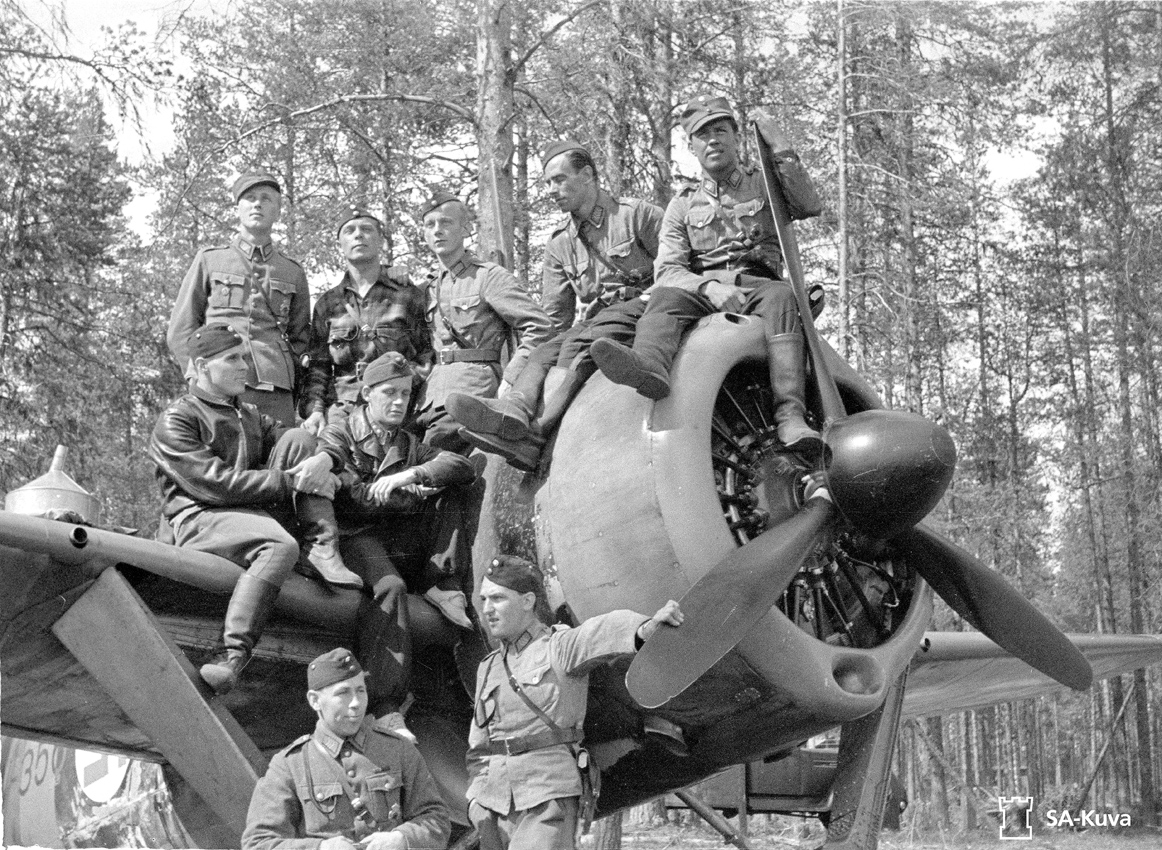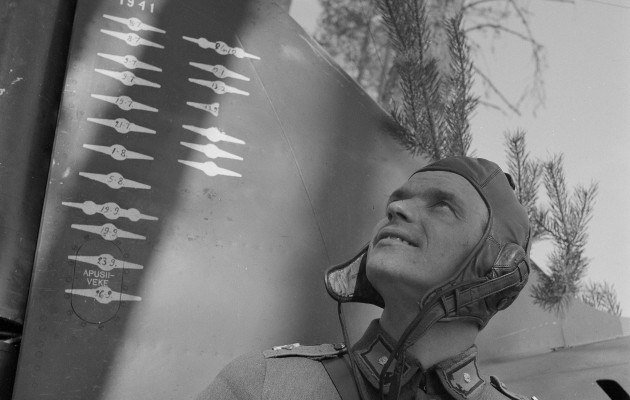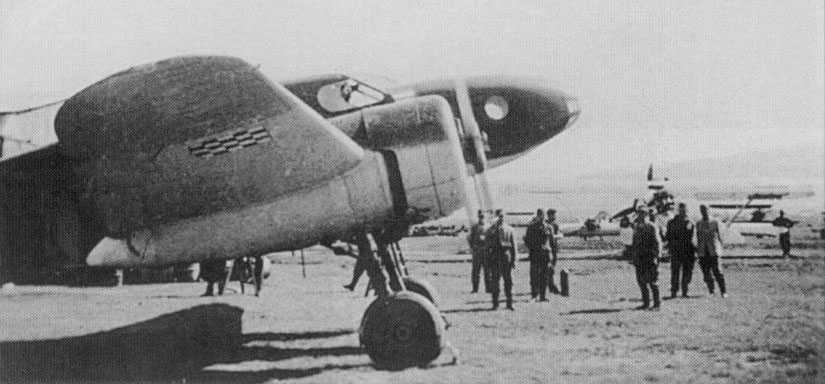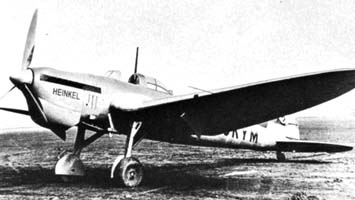Work started on the design as the Messerschmitt Me 155 in 1942, but the project went through a protracted development period and change of ownership, and prototypes were still under test and development when World War II ended.
Performance estimates of the American B-29 Superfortress reached German command in early 1942. The bomber would cruise at an altitude at which no current German plane could operate effectively. To intercept it, the Luftwaffe would urgently need new aircraft. Work on such a high altitude fighter was begun by Messerschmitt, but in 1943 the project was passed to Blohm & Voss. The result would be the Bv155 prototype that made its first test flight in September 1944.

Me 155
The story of the BV 155 began at Messerschmitt in the spring of 1942. A requirement had arisen for a carrier-based single-seat fighter to be based aboard the aircraft carrier Graf Zeppelin, then under construction. In response, Messerschmitt proposed the Me 155. In the interest of economy and simplicity, it was to use as many Messerschmitt Bf 109 components as possible, being basically a navalized version of the earlier Messerschmitt fighter.
The Me 155 was to be powered by a DB 605A-1 liquid-cooled engine of 1,475 PS (1,455 hp, 1,085 kW). The fuselage was more or less that of the standard Bf 109G, but with an entirely new wing. The undercarriage retracted inwards into wing wells, providing the wider track required for safe carrier landings. Standard naval equipment such as folding wings, catapult spools, and arrester gear were to be fitted. Proposed armament was an engine mounted 20 mm MG 151 cannon and two 20 mm MG 151 cannons and two 13 mm MG 131 machine guns in wings. It had an estimated maximum speed of 649 km/h.
Detail design of the Me 155 was complete by Sept 1942. However, the numerous delays in the Graf Zeppelin seemed to indicate that the completion of the carrier would be at least two years away. Messerschmitt was told to shelve the Me 155 project for the indefinite future. Work on the Graf Zeppelin carrier was eventually abandoned.
Me 155A
In order that all of that work on the Me 155 project not go entirely to waste, Messerschmitt adapted its design in November 1942 to match a Luftwaffe requirement for a fast single seat bomber. A single 1,000 kg SC1000 bomb was to be carried. All of the carrier equipment and most of the armament was removed from the aircraft. Additional fuel tanks were provided and an elongated, non-retractable tailwheel was added to provide ground clearance for the large bomb. The proposal was designated Me 155A.
Me 155B
By the end of 1942, the increasing number of USAAF bombing raids and intelligence coming in about the new American B-29 bomber led the Luftwaffe to envisage a pressing need for an effective high-altitude interceptor. Messerschmitt adapted the Me 155 design again to meet this requirement, merging the design with an in-house study originally designated Me 409, then later Bf 109ST; the new aircraft received the designation Me 155B. The engine was to be the DB 628, which was basically a DB 605A with a two-stage mechanical supercharger with an induction cooler. A pressurized cabin was to be provided. It was estimated that a service ceiling of 14,097 m, could be attained.
A converted Bf 109G adapted to take the DB 628 engine flew in May 1942 and attained an altitude of 15,500 m. However, the Technische Amt concluded that a DB 603A engine with an exhaust-driven turbosupercharger was more promising. The DB 603A provided 1,201 kW (1,610 hp) for takeoff and 1,081 kW (1,450 hp) at 15,000 m. This engine change required that the fuselage be elongated in order to house the turbosupercharger aft of the pressure cabin. Exhaust gases were carried to the turbosupercharger via external ducts. Air was drawn in through via a ventral trough aft of the wing. Standard Bf 109G wings were to be fitted outboard of a new, long-span, untapered wing center section. Other parts were scavenged from existing Messerschmitt designs – the vertical tail was from the Me 209, and the horizontal tail and the undercarriage were taken from the Bf 109G.
In August 1943, the RLM realised that Messerschmitt was over-committed and transferred the design work to Blohm & Voss. The design team there came to the conclusion that the existing Messerschmitt design had too many weaknesses and a complete redesign would be necessary.
In September 1943, an order for five prototypes was placed. Blohm & Voss accepted the order only on condition they had complete design freedom and were not bound by Messerschmitt's work to date. The redesign was named the BV 155. B&V gave it a new laminar flow wing and tail unit, landing gear from the Ju 87 and many other parts of the plane. Further wind tunnel testing showed that there was a serious problem with the overwing radiators, at high angles of attack the wing "blanked" them from the airflow and cooling would suffer. Work moved to a revised B model.
-----------------

General
Number built 3
Length: 12 m Crew: 1
Wingspan: 20.5 m
Height: 3 m
Wing area: 39 m2
Empty weight: 4,870 kg
Gross weight: 5,520 kg Proposal A
5,125 kg Proposal B
5,100 kg Proposal C
5,440 kg Proposal D
Max takeoff weight: 6,020 kg
Fuel capacity: 1,200 l
Powerplant: 1 × Daimler-Benz DB 603A inverted V-12 liquid-cooled piston engine with TKL 15 turbo-charger, 1,200 kW (1,600 hp) for take-off
1,200 kW at 10,000 m
1,081 kW at 15,000 m
Propellers: 4-bladed constant speed paddle bladed propeller
Maximum speed: 420 km/h at sea level
520 km/h at 6,000 m
600 km/h at 10,000 m
650 km/h at 12,000 m
690 km/h at 16,000 m
Range: 460 km at maximum continuous power with 595 l of fuel at sea level
560 km with 595 l of fuel at 10,000 m
590 km with 595 l of fuel at 16,000 m
1,080 km with 1,200 l of fuel at sea level
1,350 km with 1,200 l of fuel at 10,000 m
1,440 km with 1,200 l of fuel at 16,000 m
Service ceiling: 16,950 m service ceiling
maximum ceiling 17,100 m
Rate of climb: 11.5 m/s initial
3.92 m/s at 16,000 m
Time to altitude: 16,000 m in 29 minutes
Guns:
Proposal A
1 × 30 mm MK 108 cannon as an engine mounted Motorkanone firing through the propeller shaft
2 × 20 mm MG 151/20 cannon
Proposal B
1 × 30 mm MK 103 cannon as an engine mounted Motorkanone firing through the propeller shaft with 60 rounds
2 × 15 mm MG 151 cannon with 200 rpg
Proposal C
3 × 30 mm MK 108 cannon with 60 rpg.
Proposal D
3 × 30 mm MK 103 cannon with 60 rpg (two mounted in under-wing fairings).

-----------------
The first prototype, BV 155 V1, took off for its maiden flight on September 1, 1944. Tests with the V1 showed that the outboard radiators provided inadequate cooling, especially at high angle of attack. The intakes on the next prototype were enlarged and underslung beneath the wing rather than placed over it. However, the enlarged radiators caused a CoG problem, which required moving the pressurized cockpit forward. The Blohm & Voss team took this opportunity to replace the original Bf 109G canopy with an aft-sliding all-round vision canopy, and the rear fuselage decking was cut down. This in turn required that a larger rudder be fitted. The ventral radiator bath was also enlarged.
With these changes, the BV 155 V2 flew on February 8, 1945. Blohm & Voss was still not satisfied with the design, and before the V2 began its flight trials they proposed that the engine be switched to the DB 603U having the larger mechanically driven supercharger of the DB 603E.
The DB 603U promised a power of 1,238 kW (1,660 hp) for takeoff and 1,066 kW (1,430 hp) at 14,935 m. The ventral turbosupercharger was retained. The Technische Amt decided to accept this proposal, and abandoned all work on the BV 155B in favor of the revised design, which was designated BV 155C.
The BV 155 V2 was damaged beyond repair during a bad landing. It was to be replaced in the test program by the BV 155 V3. The BV 155 V3 differed from the V2 in having the DB 603U intended for the BV 155C. However, the engine cowling and turbosupercharger were unchanged.

Various armament schemes for the BV 155B were proposed. One proposal had an engine-mounted (or Motorkanone) 30 mm MK 108 cannon and two 20 mm MG 151/20 cannons. Another had a Motorkanone-mount 30 mm MK 103 cannon and two wing-mounted 20 mm MG 151 cannons. Estimated maximum speed was 650 km/h at 12,000 m and 690 km/h at 16,000 m. Service ceiling was to be 16,950 m. Empty weight was 4,869 kg. Normal loaded weight ranged from 5,126-5,488 kg, depending on the armament provided.
According to Pegasus Models Kit No. 5002 information sheet, V1 and V2 were both provided to the RAF after the war. V1 was flight tested until it was written off. The fate of V2 is not known. V3 is in storage at the US Air And Space Museum's storage facility.
BV 155C Project
In parallel with the prototype development, Blohm & Voss had been working on additional changes under Project 205. P.205 replaced the underwing radiators with an annular one around the front of the engine, a design feature commonly found on a number of German designs. With the wings now free of clutter, they were considerably simpler and were reduced in span. This also had the side effect of reducing the track, which would later prove to be a welcome change.
The new design would be simpler, lighter and faster, and plans were made to make it the standard version of the aircraft. During the October re-evaluation, it was agreed that V1 through V3 would be completed as B models, while a new series of five would be completed to the new standard as the BV 155C.
The BV 155C was to be significantly different in appearance from the BV 155B. The clumsy wing-mounted radiators of the BV 155B were eliminated, and the main landing gear leg attachment points were moved inboard to retract inwards. Cooling was provided by an annular frontal radiator as in the Focke-Wulf Ta 152. Large circular intakes were attached to the fuselage sides above the wing roots.
![Kuvahaun tulos haulle Lauri Nissinen Born 31 July 1918 Joensuu Died 17 June 1944 (aged 25) Kaukjärvi Allegiance Finland Service/ branch Finnish Air Force Years of service 1939–1944 Battles/wars World War II Winter War Continuation War Lauri Nissinen (31 July 1918 in Joensuu – 17 June 1944 in Kaukjärvi ) was a World War II flying ace in the Finnish Air Force . [1] Contents 1 Biography 2 See also 3 References 4 External links Biography [ edit ] Nissinen achieved 22 of his victories while piloting a Brewster B-239 Lauri Vilhelm Nissinen was born in Joensuu on 31 July 1918 and for his compulsory military service joined the Air Force, during which time he decided on flying as a career, applying for NCO pilot training in 1938. Due to his performance during training he joined HLeLv 24, flying the Fokker D.XXI in May 1939. In summer 1939 he was promoted to Sergeant. As the Winter War broke out, Sgt. Nissinen first claimed an air victory on 1 December 1939, claiming a SB-2 shot down and damaging two others over Viipuri . By the end of the Winter War he had claimed four victories in total and was a Sergeant Major. HLeLv 24 then equipped with the US- built Brewster Buffalo . As hostilities broke out again on 25 June 1941 Nissinen again flew operationally. On 7 July 1941 over Käkisalmi two enemy fighters attacked head-on, Nissinen shooting down both. On 21 July 1941 he again shot down a I-153 in a head-on battle, although his aircraft was damaged and he returned to base. His ground crew found four hits in the engine, one in the prop and several more in the wings. On 1 August 1941 at Rautjärvi six Buffalos engaged eight Soviet I-16 fighters, Nissinen's target exploding and its debris damaged Nissinen's right wing. Three I-16s attacked from behind and his fighter took several hits, shattering the windscreen. At the end of 1941 Nissinen was the second highest scoring FAF ace with 15.5 kills. Early in 1942 Nissinen attended Officer Cadet School, from where he then graduated in June 1943 as a Lieutenant. Nissinen was awarded the Mannerheim Cross on 5 July 1942, his number being 69. He held the rank of vänrikki at the time. [2] Returning to HLeLv 24 Nissinen was made a flight commander and resumed flying missions. His score increased to 26 by the end of 1943. The squadron gradually re-equipped with Messerschmitt Bf 109 fighters in spring 1944. In May 1944 HLeLv 32, flying the Curtiss P-36, was temporarily strengthened with a Messerschmitt Bf 109G-2 flight commanded by Lt. Nissinen. On 16 May Nissinen scrambled against a single Lavochkin La-5 approaching Nurmoila . The La-5 circled at 1500 m and allowed Nissinen climb to the same altitude before turning to attack from above, shooting down the La-5 after a series of exhausting attacks. With the renewed Soviet offensive on 9 June 1944 Lt. Nissinen scored two more victories on 17 June 1944 as two flights intercepted Soviet Il-2 ground attack aircraft attacking Finnish positions at Kaukjärvi . Nissinen's wingman, Sgt. Heimo Lampi saw the crippled Messerschmitt of Lt. Sarjamo dive through the cloud and collide with Nissinen's plane. Both planes exploded on impact and the pilots were killed. Nissinen flew some 300 missions and scored 32 victories in total. [3] His grave is in Valkeala . See also [ edit ] Finland portal List of World War II flying aces List of World War II aces from Finland References [ edit ] Jump up ^ Lauri "Lapra" Nissinen Archived 2009-10-15 at the Wayback Machine . Jump up ^ Hurmerinta, Ilmari; Viitanen, Jukka, eds. (1994). Suomen puolesta: Mannerheim-ristin ritarit 1941–1945 [ For Finland: Knights of the Mannerheim Cross 1941–1945 ] (in Finnish). Ajatus. p. 253. ISBN 951-9440-28-3 . Jump up ^ Stenman, Kari (2000). "Lauri Nissinen, Mannerheim-ristin ritari 69" [Lauri Nissinen, Knight of the Mannerheim Cross 69]. Suomen ilmailuhistoriallinen lehti (in Finnish) (1): 11. External links [ edit ] Lauri Nissinen at Sci.fi Categories : 1918 births 1944 deaths Finnish aviators Winter War pilots Finnish World War II flying aces Finnish military personnel killed in World War II Aviators killed in aviation accidents or incidents People from Joensuu Knights of the Mannerheim Cross Navigation menu Not logged in Talk Contributions Create account Log in Article Talk Read Edit View history Search Search Wikipedia Go Main page Contents Featured content Current events Random article Donate to Wikipedia Wikipedia store Interaction Help About Wikipedia Community portal Recent changes Contact page Tools What links here Related changes Upload file Special pages Permanent link Page information Wikidata item Cite this page Print/export Create a book Download as PDF Printable version Languages í•œêµì–´ Suomi Edit links This page was last edited on 2 February 2018, at 03:14 (UTC) . Text is available under the Creative Commons Attribution-ShareAlike License ; additional terms may apply. By using this site, you agree to the Terms of Use and Privacy Policy . Wikipedia® is a registered trademark of the Wikimedia Foundation, Inc. , a non-profit organization. Privacy policy About Wikipedia Disclaimers Contact Wikipedia Developers Cookie statement Mobile view](https://upload.wikimedia.org/wikipedia/commons/9/93/Lauri_Vilhelm_Nissinen.jpg)











